On particularly warm and damp winter nights, as thousands of Pacific newts venture out onto the verdant Petaluma hills north of San Francisco – so does the Chileno Valley Newt Brigade.
As the sunlight fades, volunteers spread out over a mile-long stretch of a rural road. Wearing reflective vests, much like school crossing guards, these brigadiers are here to help the newts make a perilous journey from a lake on one side of the road to the hills on the other. Working in pairs, they scan the road with flashlights, gently picking up each wriggly newt they find and moving them to safety.
It is, in many ways, a Sisyphean endeavor.
Thousands of these amphibians perish each year on busy San Francisco Bay area roadways. Of the few remaining populations of Pacific newts, those in the Bay Area face among the highest known roadkill rates anywhere in the world. If it weren’t for the brigade’s efforts, thousands more might die as they migrate to and from water sources for breeding season.
This winter, the brigade saved about 4,400 newts, and found 980 flattened. And cars are only one of many perils the newts encounter. Extreme, prolonged drought and heatwaves have already begun to affect California newts in the southern part of the state – and threaten to affect populations in this northern region too.
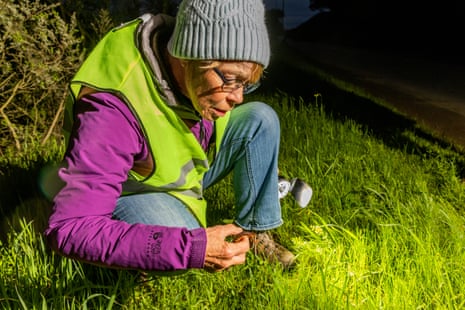
But against the incomprehensible immensity of the climate crisis and unchecked development, many of the brigade volunteers said it was the audacious smallness of the effort that appealed to them. Helping a few small newts cross a one-mile stretch of country road offers a way, they said, to keep hope.
“It’s about just getting out and just doing something,” said Sally Gale, who founded the brigade three years ago. “You don’t have to justify each effort by saying it will change the world. You just have to start somewhere.”
‘I had to do something’
On a temperate March evening, half a dozen brigadiers are out on Chileno Valley Road, adjacent to Laguna Lake where the newts breed each winter.
“Oh! Oh!” Linda Sheppard spots one, right on the lane divider. “Oh, you’re a little guy aren’t you?” She photographs him for the brigade’s records, and then gingerly picks him up and carries him across, while her partner keeps an eye out for oncoming cars. “OK, be well!”
Some nights, when misty rains coax hundreds of newts out all at once, the volunteers carry buckets to ferry them. On slower days, excited yelps pierce through the sounds of frogs and passing traffic each time someone spots one of the ruddy-brown amphibians.
Christine Davidian zips up and down the road on her bike, holding her flashlight between her teeth. Meanwhile, Richard James – who’s built a reputation around these parts for being one of the most fastidious brigadiers – is having a slower night: “Seems like Christine’s getting them all!”
Two species of Pacific newts – California and rough-skinned – live in this area. They’re difficult to tell apart, but most brigadiers are practiced at doing so. Volunteers work quickly to photograph and geotag each newt – whether dead or alive – that they spot on the road, uploading the information to the citizen science website iNaturalist.
They scrape the dead newts off the road using steel spatulas and toss them to the side. “It’s sad, just so sad,” says Kristen Franklin, a fourth-grade teacher who joined the brigade two years ago. But usually, there’s hardly any time to dwell – there are so many live ones to meet, and save.
The newts crawl slowly, timidly. “They have these cute little hands that they stretch out – like baby hands almost,” says Gale. “And they have these fat little bellies. And when they walk, they wiggle their little bottoms.”
They tend to freeze when approached – and sometimes, they flick their necks and tails up to make a u-shaped defensive pose, exposing their sunset orange undersides to signal that they’re poisonous to eat. The volunteers coat their hands in water to add a buffer between their own rough, oily skin and the newt’s soft, delicate bellies.

The newts are so discrete, so temperamentally unobtrusive, that they slip out of many Californians’ consciousness. Until recently, Gale hadn’t given them much thought either, despite having moved into her Victorian ranch house off Chileno Valley Road 30 years ago and having been involved in local ecosystem restoration efforts for decades.
Then one winter night in 2018, Gale and her husband Mike were driving back from a dinner party, when an odd compulsion came over her: she needed to get out of the car. “It was warm. There had been a good rain. And the air just felt rich,” she recalls.
And she saw the soft-bodied creatures sprawled across the road.
As Mike drove slowly behind her, she picked them up, one by one, and moved them to safety. By the time she got home that night, “I decided I had to do something”.
Bigger threats
Cars are only one of several big, existential threats that the palm-length Pacific newts are now facing. Across California, drought and habitat loss are straining already vulnerable populations.
During last year’s historically dry summer, local ranchers drained the drought-diminished Laguna Lake and planted it with cattle feed. Most larvae and juvenile newts living in it likely died, though some may have survived in the nearby marsh, Gale says. The lake refilled with the winter rains. But with more dry years ahead, she worries that the newt population will be decimated.
As a cattle rancher herself, she says she understands firsthand the pressures farmers feel. But the newts have been here for thousands of years she says – they have a right to survive as well.
In time, Gale hopes that data collected by her newt brigade will help strengthen the case for protecting California and rough-skinned newts.
Vehicles are one of the biggest threats to wildlife in California, but even as efforts to save iconic mountain lions, kit foxes and desert tortoises from road accidents gain steam, diminutive newts haven’t captured the same level of funding and commitment. Right now, researchers lack a sense of how many newts live in California and how their populations have changed over the decades.
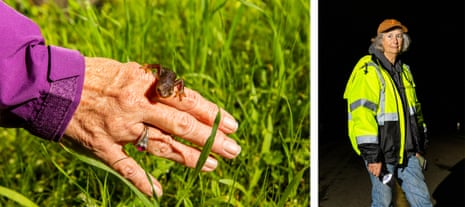
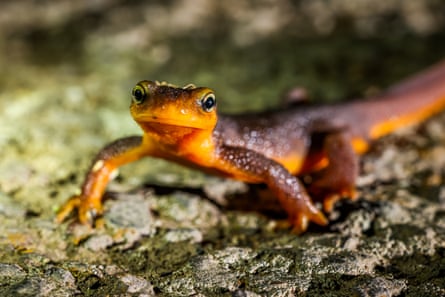
Around a hundred miles to the south of Chileno Valley Road, another group of volunteers – the Alma Bridge Newt Patrol – have been painstakingly documenting more than 5,000 newts a year that perish while crossing a four-mile stretch of road in the Santa Cruz mountains.
Unlike Gale’s brigade, the newt patrol aren’t able to save many newts – it’s illegal for them to station along the winding mountain road at night. Instead, about a dozen volunteers, led by biologist Merav Vonshak, document the dead.
“It’s really heartbreaking,” says Vonshak – especially in late fall, when many juvenile newts die. “As a scientist, I try to detach myself and focus on how important it is to document this.”
Using the volunteers’ data, researchers at the University of California, Davis Road Ecology Center discovered that the newts crossing Alma Bridge Road were experiencing one of highest roadkill rates reported for any wildlife species in the world. A study commissioned by local officials found that the adult California newt population along the Alma Bridge Road will disappear completely in about 50 years if nothing is done.
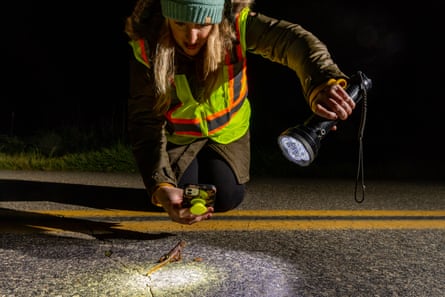
If anything, the report presented an optimistic view, Vonshak says. It didn’t consider how the climate crisis, and development would affect the population.
Researchers have found that southern California newts’ body condition – a measure comparing weight and length – declined by 20% between 2008 and 2016. It’s a sign that temperature extremes and drought – exacerbated by global heating – are already affecting Pacific newts, according to Gary Bucciarelli, a conservation biologist at UCLA who led the 2020 study. Newts in northern California are likely to suffer the same consequences in coming years, he says.
The newts are “dealing with more prolonged droughts and changing precipitation patterns due to climate change, they’re dealing with wildfires”, Bucciarelli said. “They’re getting hammered hard.”
‘You want to fight for it’
Gale knows that she and her brigade can only keep up their work for so long. “Of course, it’s not a sustainable solution,” she says.
Both newt groups have been petitioning for longer-term solutions – advocating for either closing the roads during migration season, or elevating the road so that at least some proportion of the newts to cross safely underneath.
But so far, their efforts have gained little traction. Past grant applications to elevate stretches of Alma Bridge Road and create newt crossings were rejected. And the newts, which aren’t listed as endangered or threatened, are less likely to be prioritized for existing state or federal funding for such projects.
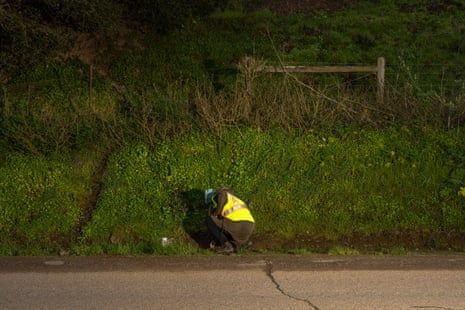
Conservationists are lobbying for a new bill, introduced in the California assembly last month, that would require the state transportation agency to implement 10 projects to improve wildlife connectivity per year. If it’s signed into law, that bill could help fund underpasses for newt populations on state roads and major highways. But since both Alma Bridge Road and Chileno Valley Road are county-managed roads, neither would be helped directly.
“It’s tough, because how long can we save the newts while we’re also building more highways?” says Paul Licht, the former director of the botanical gardens at the University of California, Berkeley – who has advised efforts to protect migrating newts. “I mean – not long.”
“But what’s your alternative? To do nothing?” he added.
That’s Gale’s view as well. And there’s something about being outside on dark, damp nights and holding up the squirming newts, she says, that can help override all the uncertainty and worry.
“It’s kind of like when you hold a human baby,” says brigadier Shannon Drew. “It’s this precious, little, perfect thing you’re holding – and you want to fight for it.”